SATURDAY
JANUARY 31 - 2015
Nore
Barn
Yesterday (Jan
30) Charlie Annalls went to Nore Barn where she saw
most of the regular birds in the stream, including the
Spotted Redshank and Black-tailed Godwits. Here is
Charlie's photo of the two species together.

Of more interest was
the Sparrowhawk that Charlie found sitting
quietly in a tree looking out to sea. She said it was
very calm and unconcerned at her presence, so she was
able to get a nice photo. From the brown barring on
the chest I think it is likely to be a male. Let's
hope this bird is one of a pair that will be nesting
again the woods this year as they have done in the
past.
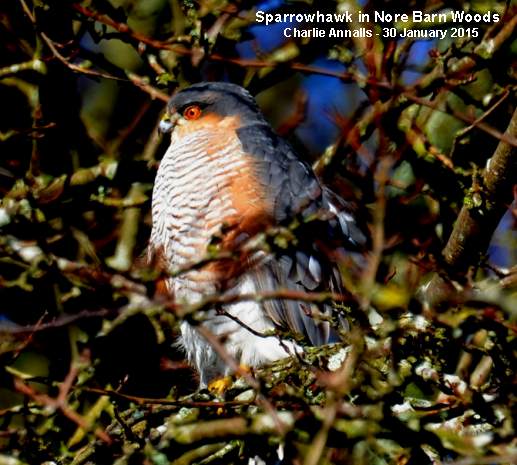
Harbour
birds
After working
all week away near Bath, Francis Kinsella was pleased
to get out with his camera for the first time in a
while. He saw lots of interesting birds on his walk
round Brook Meadow, Emsworth foreshore and Dolphin
Quay, including, two colour-ringed Greenshank,
Redshank, Black Tailed Godwit, Little Egret,
Turnstone, Grey Plover, Shelduck, Great Crested Grebe,
Curlew, Kestrel, Goldcrest and Kingfisher. Francis got
some cracking photos, particularly of our local female
Kingfisher and the Greenshanks. Francis's photo can be
seen on his Facebook album 'Before the sun sets' at .
. . https://www.facebook.com/media/set/?set=a.10152640065842011.1073741988.509257010&type=1&l=64aae3bffa
The colour-ringed
Greenshanks were G+YB and RG+BY tag. Both birds have
been previously seen in Emsworth this winter.
Red
Admiral
Chris Oakley
had his first Red Admiral butterfly in the garden
yesterday. Red Admirals can truly be regarded as
all-the-year-round insects.
Brook
Meadow
Malcolm Phillips went round the meadow this morning
and saw the Water Rail again in Palmers Road Copse.
Following his cracking photo of a Blue Tit yesterday,
Malcolm got an equally good photo of a Great Tit
this morning.

The sexes of Great
Tits are a bit easier to distinguish than those of
Blue Tits. Males have a wider black belly stripe,
especially between the legs. The stripe is narrower on
the female, breaking up or fading between the legs.
The black stripe on the bird in Malcolm's photo is
quite broad between the legs which suggests it is a
male.
Malcolm also noted that the bird box in the tree just
up from the south bridge has come away from the tree
and looks in danger of falling on someone. The
conservation group have been informed.
FRIDAY
JANUARY 30 - 2015
Emsworth
news
The pair of
Mute Swans from the Slipper Millpond nest were
back in the harbour by the quay with their two
cygnets, which I thought they had abandoned. The cob
was continually making fairly half-hearted attempts to
chase the cygnets off, but they kept coming back.
Maybe the parents were missing them on Slipper
Millpond?

Coming back via Peter
Pond I spied the regular female Kingfisher
perched on the table in the reeds at the northern end
of the pond. This perch is easily viewed from the
track that goes to Gooseberry Cottage.

Malcolm Phillips went
around the meadow this morning and down to Peter Pond
where he also saw the Kingfisher on the table. While
on Brook Meadow he got this lovely shot of a Blue
Tit.

The sexes of the Blue
Tit are not easy to distinguish. Generally, the books
and the internet sites say the male is brighter
overall than the female. One of my books adds that the
male has a broader, deeper blue necklace and darker
wing coverts than the female. Looking at Malcolm's
photo my inclination is to go for female, but I might
be totally wrong! The only sure way is in behaviour;
the female builds the nest and sits on the eggs; the
male brings her food and then they both feed the
chicks.
THURSDAY
JANUARY 29 - 2015
Emsworth
I had a walk
round the millpond this morning where the two pairs of
Mute Swans were just moving around each other with no
clear aggression.
I found a colour-ringed Greenshank G+BN tag in
the channel east of the Emsworth Sailing Club building
feeding with a Little Egret and a Common Redshank.
G+BN was one of the 13 caught and ringed by Pete Potts
and his team at Thorney Deeps on Jan 13, 2014. This
was our 4th sighting of this winter. The geo tag which
is attached to the black ring cannot be seen on this
photo, but it is a device that records the movements
of the bird as it travels to and from its breeding
grounds.

I counted 21 Mute
Swans in the harbour near the quay, an unusually
large number. They included 5 juveniles which are most
likely to be cygnets rejected by their parents.
However, the lone cygnet on the town millpond remains
close to its parents.
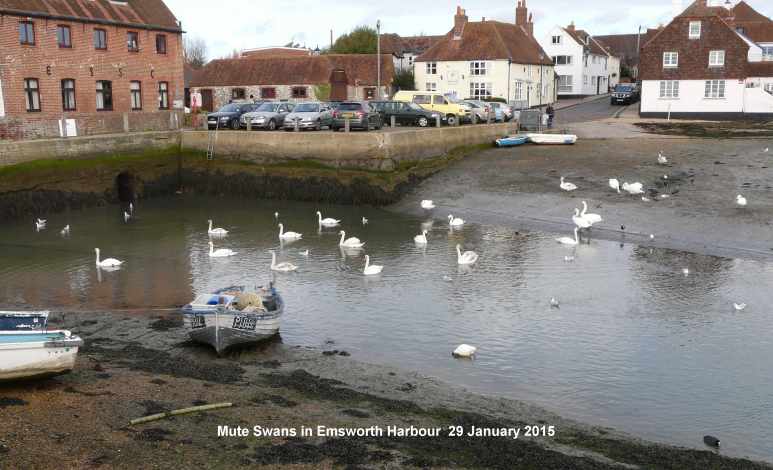
The cob Mute
Swan of the pair that nested on Slipper Millpond
last year was standing proudly on the east bank of
Peter Pond when I passed by. Its mate, the the
'Polish' variety with pink legs, was on Slipper
Millpond. I assume the swans will nest in the reeds on
Slipper Millpond as they did last year, producing two
cygnets.

Brook
Meadow
I happened to
bump into Malcolm Phillips while walking through Brook
Meadow this morning, it was a chilly day and we were
both shivering. Malcolm was not having a great deal of
luck with his birds, but he was pleased to get a photo
of a Goldcrest on the river bank near the old
gasholder - the smallest bird in Britain and never an
easy one to photograph.

After I left him
Malcolm walked over to Peter Pond where he saw a
Kingfisher in the area where the reeds have been
cleared opposite Gooseberry Cottage. Then on the way
back Malcolm managed to get a Water Rail on the
river bank in Palmers Road Copse, though he had watch
it for about half an hour before getting a reasonable
photo. Palmer's Road Copse is the best place to see
the bird at present.

WEDNESDAY
JANUARY 28 - 2015
Emsworth
in Flora News
I was
delighted to see that Martin Rand has included three
of the rare plants that I discovered in Emsworth in
the list of records in the Flora News No 48 Spring
2015. Two of them were on waysides and the other on
Brook Meadow.
Allium
roseum (Rosy Garlic): Cotton Drive, Emsworth,
SU7437 0735; First recorded in May 2014. First for
square SU70.

Sanguisorba
officinalis (Great Burnet): Brook Meadow,
Emsworth, SU7507 0613. Confirmed by Martin Rand. He
thinks perhaps introduced. New tetrad record. First
seen in June 2013. It returned in 2014 with a maximum
of 28 flowering heads.
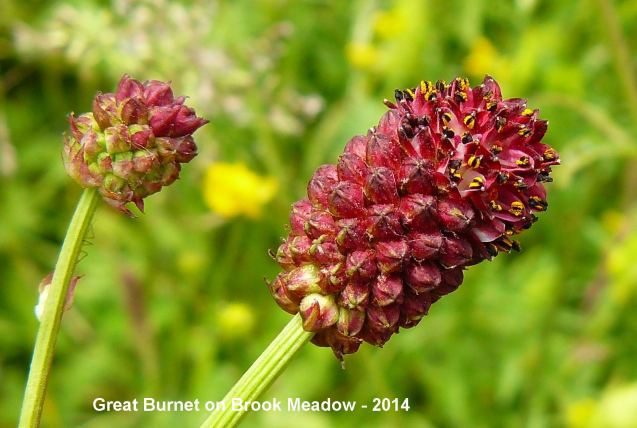
Torilis
nodosa (Knotted Hedge-parsley): Found on three
waysides: Christopher Way - first seen in 2010.
Westbourne Open Space first noted in 2011. New
Brighton Road Junction first seen in 2014. New tetrad
record and a Hampshire notable.
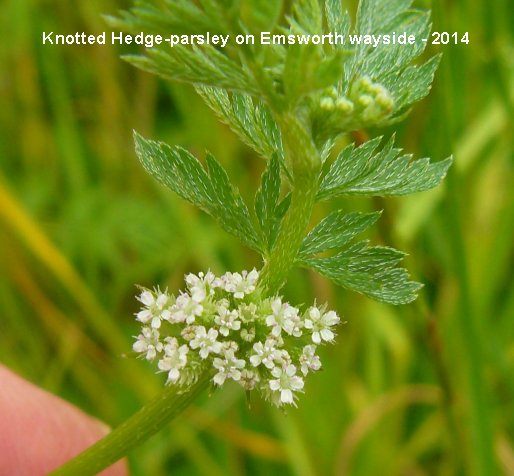
Other
notable local records in previous Flora
News:
Rhinanthus
minor (Yellow-rattle): Brook Meadow
Established here from introduced seed. First for SU70
since 1970. THis is now abundant in the orchid area on
Brook Meadow.

Eleocharis
uniglumis (Slender Spike-rush): Brook Meadow
SU751 060; 4 Jun 2012; Small patch reasonably dense
over c.2 x 1m, in slightly brackish influenced part of
meadow, with Carex divisa and Carex distans nearby. SU
7513 0604. New tetrad record. A Hampshire notable.

This plant was
actually found by John Norton and Eric Clement. I just
happened to be there at the time. However, I have
successfully found the plants in subsequent years.
Here is a photo of John examining the plant with Ralph
Hollins while Eric looks at grasses, taken on Brook
Meadow when the Slender Spike-rush was first
discovered.

Polypogon
viridis (Water Bent): Found by the wall of
house and driveway to garages in St James Road
Emsworth, SU747 059; 4 Jun 2012. Also, one plant on
pavement. 1st for SU70.

Salvia verbenaca
(Wild Clary): First discovered on the
Christopher Way wayside in 2010 SU749069. There were
40 plants in 2011 and 2012. They were all gone in
2013, but a few returned in 2014. 1st for
SU70.
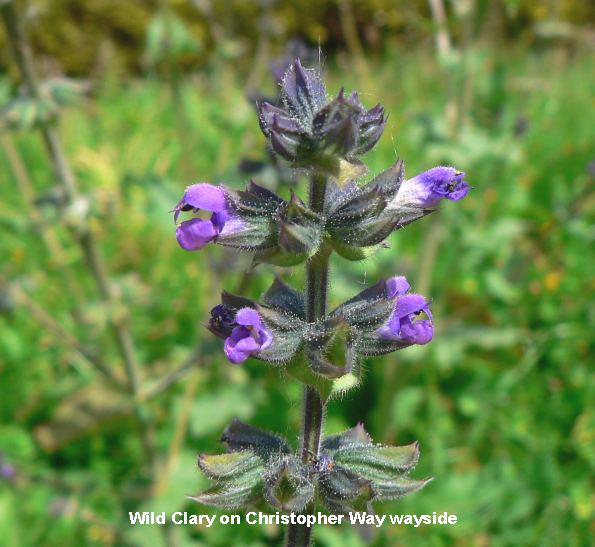
Mystery
Barnacle Geese
Ralph Hollins
has done some research on the destination of the 75
Barnacle Geese that Peter Milinets-Raby saw flying
over Langstone on Jan 26. He thinks the most likely
answer is that they were on a strange route to the
Solway Firth. See Ralph's diary for Jan 27 for more
details . . . http://ralph-hollins.net/Diary.htm
TUESDAY
JANUARY 27 - 2015
First
Lesser Celandine
It was quite a
nice morning for a stroll. Robin, Blue Tit, Dunnock
and Collared Dove were singing in Bridge Road car
park. I was pleased to find my first Lesser Celandine
flower of the year beneath the Beech hedge at the
southern end of the car park. This was by no means the
earliest Lesser Celandine locally as Ralph Hollins
counted 20 flowers fully open in Juniper Square in
Havant on Jan 24, but it's a good start.
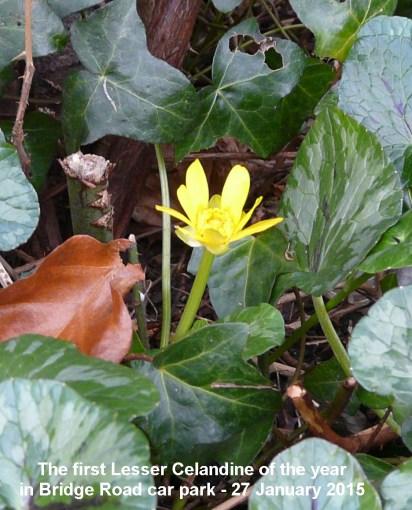
Reed
clearance on Peter Pond
I noticed that
David Gattrell has been busy on Peter Pond, doing the
biennial clearance of reeds on the western side of the
pond, opposite Gooseberry Cottage. David does a very
good job in managing the pond environment and making
it friendly to a variety of wildlife. Over the past
couple of years, David has also created two new
channels through the reedbeds where the Lumley Stream
enters Peter Pond. This creates new habitats as well
as improving the flow of stream water.

Italian
Lords-and-Ladies
The mottled
leaves of two plants of the unusual Italian
Lords-and-Ladies (Arum italicum ssp italicum)
are now showing well on the west bank of the river in
Palmer's Road Copse, just north of the south bridge.
They have been here for several years. This subspecies
was cultivated in Britain by 1683 and was known from
the wild by at least 1905. It is popular in gardens,
and its distribution is probably increasing. It has a
Mediterranean-Atlantic distribution.
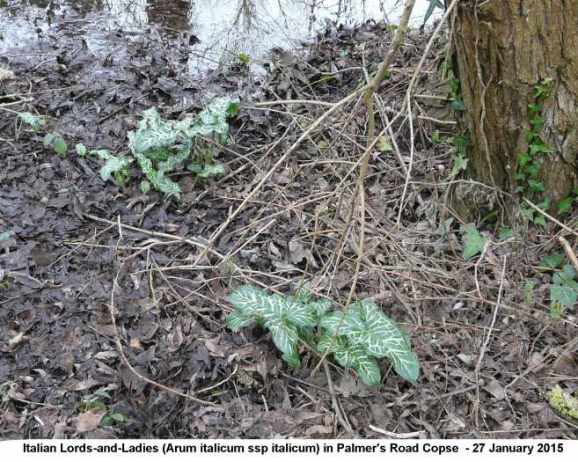
Mystery
honking
While walking
through Brook Meadow I heard some loud goose-like
honking calls which appeared to be coming from the
garden of Gooseberry Cottage. I rushed over there, but
I could see nothing to cause this sound. Then I heard
the same honking coming from the river area in
Palmer's Road Copse. Again, I went over to have a
look, but with no success. Drat, I must have missed it
again. So the honking remains a mystery. It is
difficult to imagine a Canada Goose getting into that
habitat, though one never knows.
Ivy
berries
Malcolm
Phillips went round Brook Meadow this morning and was
most impressed by the display of berries on the Ivy
bushes. Malcolm's photo shows the berries in various
stages of development. Ivy berries are a very
important food source for birds at this time of the
year when most other berries have disappeared. So,
please avoid cutting your Ivy until a bit later.
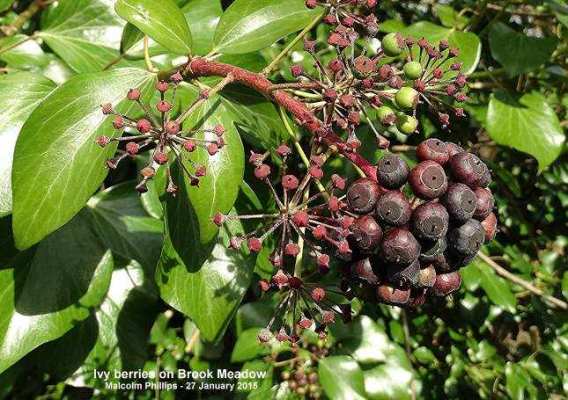
Coal
Tit in garden
I was pleased
to see a Coal Tit in my garden this morning. Coal Tit
is a fairly rare bird in our garden with only about 3
or 4 sightings each year, usually early in the year
like this one. I managed to get a shot of this active
bird through the window. The open bill shown in the
photo suggests the bird might have been singing,
though it could equally have been consuming some food
item. The Coal Tit has a very characteristic feeding
behaviour; it goes to the feeder, takes a seed and
then flies to a nearby tree to consume it.
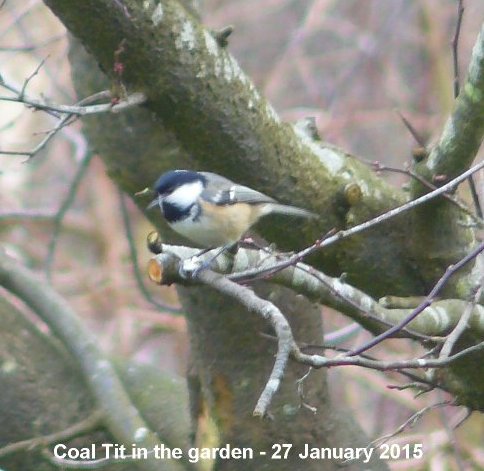
On average the Coal
Tit is ranked 14th in the BTO garden bird list for the
winter period in SE England being recorded in 41% of
gardens. From these figures I guess my garden is a bit
below the average in Coal Tit recording. Coal Tit is
seen more often in gardens in the north of England
where there is a 61% recording rate.
See . . . http://www.bto.org/volunteer-surveys/gbw/results/ranking-bird-species-reporting-rate
Buzzards
fighting
Thanks to Dave
Oliver for forwarding this dramatic report from Mike
Sweeney of a sighting he had while he and his wife
were walking through the woods at Kingley Vale.
Mike writes: "Suddenly a Buzzard made a really loud
call, much louder than normal and clearly something
was up. Then about 3 seconds later there was a loud
crash and two Buzzards, locked claw to claw, fell
through the canopy and hit the ground about 20 metres
away from us. They stayed locked together for about 10
seconds, viciously pecking at one another. Then one
broke free and they few off in separate directions. I
suppose it was a territory dispute or perhaps and
argument over a female. It was spectacular whichever
way you look at it. Sadly no photos, it was all too
quick."
Here is a link to a
video of two Buzzards fighting over food . . .
https://www.youtube.com/watch?v=9BYtn7wEMck
Apparently, fighting
between Buzzards is not uncommon, usually over food or
to trespassing over territories according to BWP. Tony
and Hilary Wootton reported a similar encounter while
walking near Winchester in February 2005. Tony wrote:
"On the ground in a ploughed field were 3 buzzards and
2 crows. 2 of the buzzards were fighting or mating and
the third was a looking on from 20yds away. The
buzzard on the ground was certainly on its back so I
think they were fighting not mating. They were
stationary for 30 secs or so then burst into furious
activity followed by another period of quiet. After 7
or 8 minutes of this they packed up and both flew away
with no signs of obvious injury. All the time they
were doing this, on of the crows kept sneaking in and
pecking them. I couldn't tell if it was both buzzards
or only one. After they all flew off we had a good
look for any signs of prey but saw
nothing."
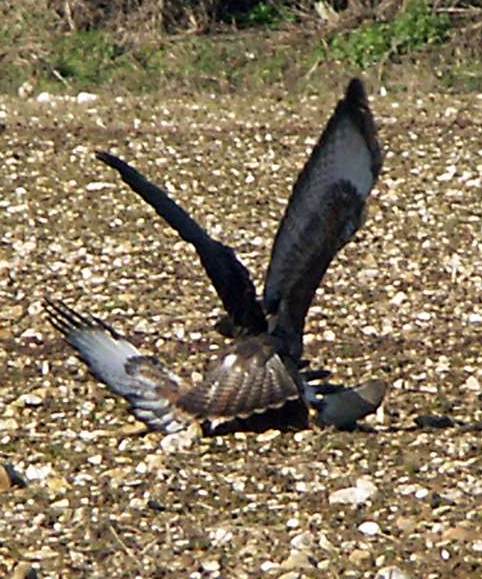
MONDAY
JANUARY 26 - 2015
Bridge
Road Wayside
Walking out
this morning I came across a group of Havant Borough
Council workers clearing the brambles and other
undergrowth from the north shrubbery in Bridge Road
car park - just a few yards from my house. This is, of
course, one of the Emsworth waysides. The leader, Lee,
told me they would be leaving the mature trees and
bushes, but clearing the rest. This is a good move as
it will tidy up that area of the car park which is
ecologically of little significance and collects a lot
of littler which is hard to get at. This is in
contrast to the central shrubbery which should not be
touched as it houses a flock of House Sparrows as well
as many other bird species. Lee assured me they were
going no further. The Beech hedge would be tackled on
another day.

Mute
Swan news
There was
nothing of special interest on the millpond this
morning, but I was surprised to find three cygnets
in the channel beneath the quay. They presumably
include the two now abandoned by their parents who
have returned to their nesting site on Slipper
Millpond plus one other rejected from somewhere else.
It was not the lone cygnet on the town millpond which
is still enjoying the company of its parents - for the
time being, at least.
Brook
Meadow
Malcolm
Phillips went round the meadow this afternoon and saw
a Water Rail in the flooded area of Palmers
Road Copse, but could not manage a photo. Malcolm
waited about half an hour to see if it would reappear
but no luck. Here is one he took last month, just in
case you could not remember what it looked like.

That was out first
sighting of a Water Rail on Brook Meadow for nearly a
month. It could well be another bird than the one we
saw regularly by the S-bend in the river from
22-Sep-14 to 21-Dec-14.
Although Malcolm did
not get the Water Rail this time, he did snap this
rather nice Chiffchaff on the meadow. I think
it is a regular common Chiffchaff and not the Siberian
version which we have not seen since 14-Jan-15. It
could possibly have moved on.

Song
Thrushes
Patrick Murphy
has had a pair of Song Thrushes in his north Emsworth
garden. He managed to get a photo of them feeding on
the droppings from the bird feeders, sun flower
hearts, fat balls and bird cake. This could be a pair
of local birds preparing for the breeding season, or
possibly winter migrants from the Continent. Patrick
will keep us informed of any further sightings.
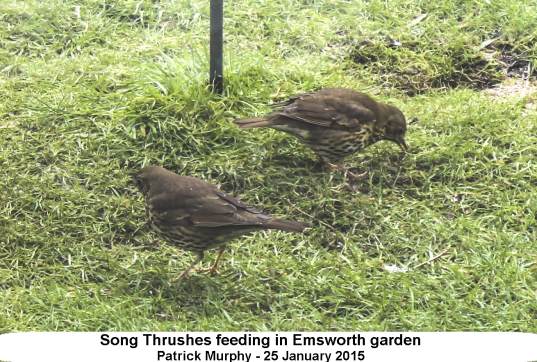
Langstone
shore
On Saturday
(Jan 24), Charlie Annalls took a walk from the car
park near the sewage works in Bedhampton along past
Southmmoor to The Royal Oak and then on to the
paddock. She got two more firsts for her, following
the Kingfisher on Peter Pond and the Blackcaps in her
garden. She says, "January 2015 is turning into an
amazing month for me."
Charlie's first first on Saturday's walk was a
Goldcrest in the brambles at the car park at
the end of Southmoor Lane. She didn't realise what it
was until she got home to check the photos and was
thrilled to see the distinctive yellow crown patch.

Charlie's second first
was the long-staying female Goosander on
Langstone Mill Pond, shown here having a good splash
and clean up.

Petersfield
Heath
Mike Wells
spent about three hours at Petersfield Heath over the
week-end and saw lots of birds most of which were too
fast for a photo. However, he did get some very cute
photos of Long-tailed Tits. Here is one I like
in particular.

Mike also got this
cracking Great Crested Grebe on Petersfield
Pond.

Mute
Swan 'busking'
Ralph Hollins
reminded me that the familiar Mute Swan threat
display, with neck curved back and wings half raised,
which we are seeing a lot of from the swans on the
town millpond currently, is known as 'busking'. Both
feet are paddled in unison during this display,
resulting in more jerky movement.
Here is a pair of
swans busking on Slipper Millpond that I took several
years ago

Long-tailed
Tit song
On Sunday Jan
25, Ralph Hollins heard what sounded a little like
Blue Tit song though something about it was not quite
right - it was too rhythmic and sounded almost
mechanical. He soon spotted the birds from which the
sound was coming and they were all Long-Tailed Tits.
He then found a Youtube video which confirmed that
that this was in fact a Long-tailed Tit song,
something Ralph had never knowingly heard before! He
says, we are all familiar with the normal rattling
contact call of these birds but the song is much
quieter and higher pitched with a rhythmic "tsee tsee
tsee tsee" sound. He says you can hear it among the
normal contact calls in a YouTube video at . . .
https://www.youtube.com/watch?v=pBGp25R6nBY
Personally, I could
not hear the song on the video. However, the song is
clearly discernable on Disk 4 (Song 36) of the Jean C
Roche Bird Songs of Britain and Europe if you have the
CDs. But I am not sure how to put the song onto this
blog.
Langstone
Mill Pond
Peter
Milinets-Raby loitered down the Langstone Mill Pond
today from 11:35am to 2:17pm - tide pushing in
eventually. Here is his report along with some
interesting photos:
Langstone Mill Pond: Male & female Wigeon,
Cormorant swimming around, 7 roosting Little Egret, No
visible sign of anything in the Holm Oak nests,
however the south nest contained two birds, one
standing, the other sitting. Flooded horse paddock: 48
Teal, 27 Moorhen,
Off Pook Lane: A very impressive flock of Brent Geese
flew off the Castle Farm fields and landed in the
channel. A through count revealed 1,181 birds! By the
end of the visit they had all returned back to the
fields.
A
very muddy Redshank - almost unrecognisable

5 Greenshank
(G//R+BRtag//-), 85 Bar-tailed Godwits, 19 Knot, 61
Dunlin, 32 Golden Plover, 62 Shelduck, 82 Lapwing, 17
Red breasted Merganser, 1 female Goldeneye, 7 Grey
Plover, 14 Black-tailed Godwits (B//R+GO//- and
G//R+LG//-) - photos attached showing rings and
how dirty the water spurting can be when the birds
want to spit out their gullets full of sea water and
mud! B+GO was at Nore Barn on 06-Jan-15.
And, then at 2pm a
noisy (different sounding honk) flock of 75
Barnacle Geese flew in from the west, circled once
over the channel and then headed north west high over
the Hayling Bridge. I wonder where they had come from
and where they were going!" I think we would all like
to know that. Wild or feral?
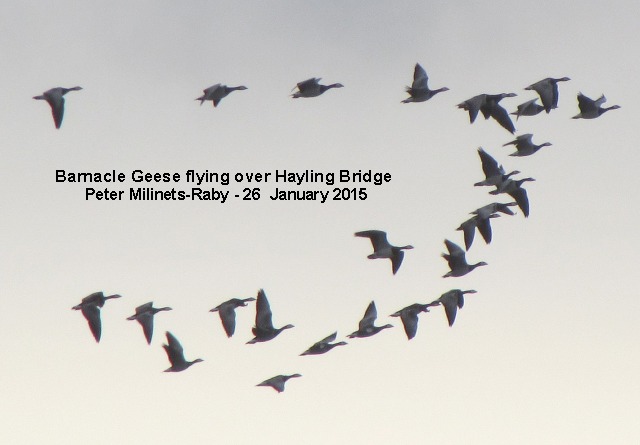
Tufted
Ducks at Baffins
Reading about
the lack of Tufted Ducks at Emsworth, Eric Eddles
thought I might like to see this shot taken at Baffins
Pond last Friday. Can we have some please?

Nesting
season starts early
In view of the
photo Malcolm Phillips got of a Long-tailed Tit
collecting nesting material on Brook Meadow on it is
not all that surpising that the BTO has received
several reports of early nesting including an
extremely early clutch of Robin eggs, Moorhens on eggs
and a nest of Mistle Thrushes in a Glasgow Park that
has successfully fledged in recent weeks.
See . . . http://bto-enews.org/NXK-344LJ-3UEDCR-1G2XHM-0/c.aspx
SUNDAY
JANUARY 25 - 2015
Emsworth
It was a very
pleasant morning for a walk around the local area,
chilly, but the sun was poking through the clouds and
there was no wind. On Emsworth Millpond I found the
two pairs of Mute Swans on their respective northern
and southern territories, well away from each
other.
Walking round the millpond seawall I witnessed a fine
spectacle of several hundred Brent Geese sailing down
into the harbour in skeins, honking noisily as they
came. They had probably been feeding in the fields
somewhere.
Here
is a photo of a few of
them.

I met Malcolm Phillips
who was bemoaning the fact that he got no photos at
all on Brook Meadow. He did much better at Nore Barn -
see below for his photos.
The two cygnets
from the Slipper Millpond brood were alone near the
quay, clearly abandoned by their parents whom I saw
chasing one of them off earlier in the week.

I went over to Slipper
Millpond where I found both the parent swans back on
their nesting territory; the female 'Polish' swan was
conveniently showing one of her pink feet to confirm
their identity as the pair that nested here last year.

Walked back through
Brook Meadow where a few Butterbur flowers were
just emerging on the western side of the meadow just
below the seat.

Nore
Barn
Malcolm
Phillips went onto Nore Barn after I met him on the
millpond seawall and got a few pics, including our old
friend the Spotted Redshank which is now in its
11th winter running in Emsworth and a Black-tailed
Godwit in flight showing off its white wing bar
(which distinguishes it from a Bar-tailed Godwit which
has plain wings).
Emsworth
to Warblington
Peter
Milinets-Raby walked from Emsworth to Warblington on a
chilly grey morning:
Emsworth Mill Pond sea wall (southern half of the pond
frozen over - 7:52am as the sun rose - Extremely low
tide throughout so not ideal conditions to count
stuff!!)
5 Pied Wagtails on the sea wall, Rock Pipit calling
from somewhere, 346 Brent Geese, 92 noisy Canada Geese
in the channel by the town (one with extra white on
the face?), 48 Coot that I could see. 23 Lapwing, but
could not find any Turnstone?? 8 Grey Plover, 4
Dunlin, 3 Greenshank, Male & female Red Breasted
Merganser, 6 Gadwall (3 pairs), 1 Kingfisher perched
on boat, 1 Little Egret in stream, 7 Shelduck.
Mill Pond outflow (from 8:20am): 7 Wigeon, 37 Brent
Geese, 1 Grey Plover, 16 Dunlin, 3 Teal, 1 Little
Egret.
Off Beacon Square (from 8:35am): 41 Brent Geese, 3
male & 3 female Pintail, 11 Wigeon, 41 Dunlin, 4
Shelduck, 2 Black-tailed Godwit.
Nore Barn (From 8:44am - Ridiculously low tide and
everything disturbed by two guys walking out along the
stream to the main channel to collect a boat!!!). 86
Teal, 59 Wigeon, 14 Black-tailed Godwit, 4 male &
2 female Pintail, 57 Dunlin, 2 Grey Plover, 9
Shelduck, 31 Brent Geese.
Warblington cemetery (from 9:03am): Chiffchaff, 2
Goldcrest.
Conigar Point (from 9:20am): 36 Shelduck, 43 Dunlin, 6
Lapwing, 23 Teal, 4 male & 4 female Pintail, 15
Wigeon, 2 Grey Plover, 9 Brent Geese.
Pook Lane (from 9:40am): 48 Shelduck, 29 Wigeon, 117
Bar-tailed Godwit (feeding together with the Knot -
impressive sight), 113 Knot, 55 Lapwing, 123 Brent
Geese on the mud and 461 Brent on the field beside the
church with 2 Lapwing. 14 Red breasted Merganser in
the trickle of water left in the channel, 1 female
Goosander feeding in the channel away from the
Mergansers, 9 Little Egrets in the channel, 2 female
Goldeneye in the channel, 7 Grey Plover, 29 Golden
Plover, 1 Greenshank, 12 Black-tailed Godwit, 47
Dunlin. Very few Dunlin in view today !!!
SATURDAY
JANUARY 24 - 2015
Blackcap
in garden
Joyce Sawyer's
husband managed to get this rather fine action shot of
the male Blackcap that has been visiting their garden
in Denvilles. Clearly, it has taken a liking to the
fat balls.

Malcolm's
pics
Malcolm
Phillips had a quick walk round Brook Meadow this
morning and got photos of some of our common birds
that are often not featured in this blog. Thanks
Malcolm. From right to left: Blue Tit, Great Tit,
Blackbird (female), Song Thrush.
FRIDAY
JANUARY 23 - 2015
Millpond
News
I walked over
to the millpond this afternoon (3.30 - 4.00) to see
how the warring Mute Swans were doing. Both pairs were
close together on the east side of the pond at the end
of Nile Street, but only sparring, not fighting in the
half an hour I was watching them. This takes the form
of the two males circling around each other with wings
raised. The two females were nearby, but generally did
not get involved.

Here is a link to a
YouTube video clip of the Swans' activity . . .
https://www.youtube.com/watch?v=gql-4nr0L1k&feature=youtu.be
Most of the 100 or so
gulls were standing on the ice which covered mainly
the southern section of the pond. They were mostly
Black-headed Gulls with 5 Common Gulls and a couple of
Herring Gulls. I went through the Black-headed Gulls
looking for rings, but did not find any.
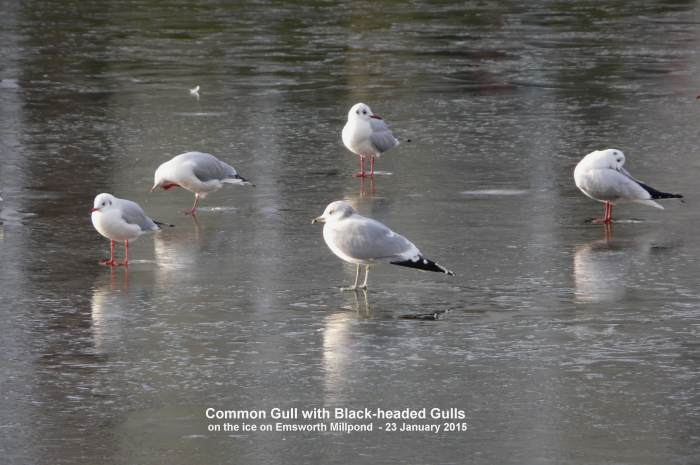
As usual a good number
of Mallard had migrated onto Bridgefoot Path and where
they were blocking the passage of cars along the road.

Harbour
news
The tide was
high in the eastern harbour, so no sign of any waders.
I counted 92 Coot in the harbour near the
eastern shore, which looks like our quota of wintering
birds this year.
The Mute Swan
family near the quay only had one cygnet with the
two adults. This probably means the second cygnet
which I saw being chased by one of the adults
yesterday has now been driven off for good. The adults
appeared to be fairly relaxed with the remaining
cygnet, though I suspect that will be chased off too
in the near future.
Brook
Meadow
Malcolm
Phillips went round a very frosty Brook Meadow today.

Langstone
Mill Pond
Peter
Milinets-Raby says it was -4.7C in his back garden
this morning, so he was not at all surprised to see
the Langstone Mill Pond 3/4 frozen over! He visited
between 11:27am to 1:40pm (High tide) Here are the
highlights:
Tiny piece of salt marsh left, which held 8
Black-tailed Godwit, 2 Dunlin, 2 Lapwing, 1
Greenshank, 2 Grey Plover.
On the high tide water in the channel: 79 Shelduck, 51
Teal, 76 Wigeon, 350+ Brent Geese, 4 Red Breasted
Merganser, 2 male & 2 female Pintail.
Frozen horse paddock: No Teal, 3 Foxes, 25 Moorhen, 2
female Pheasant.
Langstone Mill Pond: Great to photograph the duck etc.
on the ice!! Male & female Wigeon, Female
Goosander on the tree at the back, mostly asleep the
entire visit.
Breeding Grey Herons:- Top nest on the Holm Oak
visited twice by male with huge sticks. The female was
sitting out of sight and her head could be seen
re-arranging the sticks before settling down again and
out of sight. Lower Holm Oak nest. Bird briefly stood
up and fiddled with the sticks at her feet, then
settled down and disappeared behind the foliage. South
Nest: Two birds still present. Lots of noise from
these two!
The bird of the morning was the very obliging Water
Rail that was wandering around on the ice and
occasionally on the path!!!

Rock
Pipits
Eric Eddles
has been following the discussion on this blog (Jan
22) about an unusual Rock Pipit at Nore Barn. He says
there is a regular pair of Rock Pipits that can be see
on the old shingle jetty opposite Tangier Road on the
Eastern Road - known as Salterns Quay. Eric sent me a
cracking photo (below) of one of the birds on
26-09-14. This bird has the black legs which Ralph
Hollins associated with Rock Pipits, though now admits
they are not always black, but sometimes dark red.
However, they are never pink like those of a Meadow
Pipit. As to whether Eric's bird is a Scandinavian
Rock Pipit (Anthus littoralis) I have no idea
and will leave that to others to judge.
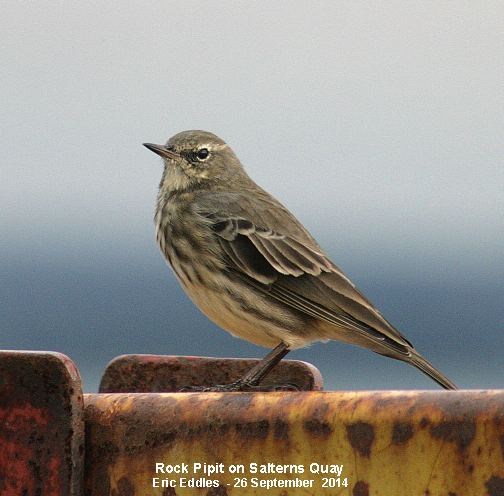
Bumper
cone crop
Kevin Sayer
posted the following message on Hoslist which will be
of interest to local garden bird watchers. "You may be
wondering why there are so few Siskins & Redpolls
at your feeders this winter. The posting below from a
Scottish Ringer may offer a reasonable
explanation."
"The cone crop of spruce in plantations across the
northern half of the UK is massive this year. This is
well shown on a recent episode of BBC TV Winterwatch
programme. The pictures show the abundance of cones
well, and this is the same right across Scotland. So
there was no need for Siskins, Redpolls or Crossbills
to head south in the autumn - which may explain your
low numbers this winter. Spring 2015 should be a
bumper breeding season, then if the cone crop fails
next summer, there should be lots of birds heading
south."
Little
Egret catches rodent
Christopher
Evans has been enjoying this blog since Ralph Hollins
recommended it a few months ago. Now he makes his
first contribution. Christopher's photo of the Egret
is interesting as it shows it catching an unusual
prey.
"Walking down the Hayling Billy trail this morning I
was watching a Little Egret in the stream alongside
Wade Court. I suddenly realised it had caught
something and was surprised to see that it was a mouse
or a another small rodent that it had obviously
plucked off the bank. A few seconds later, down it
went. Also in the stream was a Grey
Wagtail."

THURSDAY
JANUARY 22 - 2015
Nore
Barn Spotted Redshanks
Jean and I
walked to Nore Barn this morning. The tide was fairly
high by the time we got to Nore Barn at 10.30, but we
were pleased to see two Spotted Redshanks still
feeding happily in the stream, that is until an unruly
dog ran in to disturb them. But, they came back, as
they always do, and I managed to get a shot of them
fairly close together. Neither had rings.

I have seen two
Spotted Redshanks at Nore Barn on several occasions
this winter. However, the once familiar colour-ringed
Greenshank G+GL has not been seen since early
December; it appears to have gone off somewhere else.
One of the two Spotted Redshanks will be the regular
bird that has been at Nore Barn for the past 11
winters running.
Interestingly, Ralph
Hollins was at Nore Barn on Tuesday (Jan 20) when he
had the impression that the Spotted Redshank came back
to the shore not from over the open sea, as is usual,
but from an upstream roost site beyond the trees
adjacent to Maisemore Gardens. That is something I
have never seen. There is a small pond in the woodland
area that the Nore Barn Woods volunteers have been
clearing out. Maybe it has discovered that.
Unusual
Rock Pipit
When Ralph
Hollins was at Nore Barn on Jan 20 he found a lone
Pipit on the grass (the shingle was covered with a
high tide at that time) near the Picnic table. The
bird behaved like a Rock Pipit but did not have the
dark underparts and black legs of the Rock Pipits that
Ralph has seen on the South Moors shore. See Ralph's
diary for Jan 20 at . . . http://ralph-hollins.net/Diary.htm
Since then he has come across a PDF with several
photos of Rock Pipit, most of which do not have the
black legs that he thought were an essential feature
of Rock Pipit. Ralph's conclusion is the bird was a
Scandinavian Rock Pipit (Anthus littoralis). See . . .
http://www.manchesterbirding.com/logicalityoflittoralisiddocmanchesterbirding.com.pdf
It will be worth
keeping an eye out for this bird or other Rock Pipits
that might be in the local area. Photos would be a
great help. However, the article referred to by Ralph
stresses the difficulty in separating the two races of
Rock Pipit which can be very variable in their plumage
features with a good degree of overlap. It concludes
that only extreme examples of A. littoralis should be
identified with any degree of confidence.
Photo
of a Rock Pipit taken on the shore of Emsworth Harbour
in November 2011 by Romney Turner
It shows well the dark plumage of the bird.

Here
is a photo I got of a Rock Pipit at Nore Barn in
February 2012.

Swans
chasing off youngsters
When Jean and
I got back to the harbour at the end of South Street,
we found the Mute Swan family with two cygnets from
the nest on Slipper Millpond in their regular spot
near the quay. The cygnets are now acquiring their
white feathers though it will be a couple of years
before they become completely white.
Interestingly, while we were watching, one of the
adult swans made several attempts to chase off the
cygnets, but without much success as they kept coming
back. The adults in a pair usually do chase off the
offspring from the last brood at this time of the year
before they get back down to nesting again. The
cygnets certainly should be gone when the adults move
back to their nesting site on Slipper Millpond or
Peter Pond.

Millpond
- Red-breasted Merganser
Looking across
the millpond, we could see the distinctive shape and
black and white colouring of a male Red-breasted
Merganser on the pond. The photo shows well the red
eye and the typical shaggy hair style of the bird.
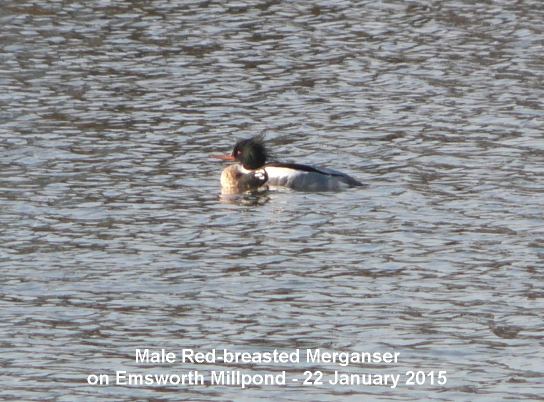
Red-breasted
Mergansers of both sexes have been fairly regular
visitors to the millpond this winter and have been
reported by several people. In contrast, Tufted Duck
have been very scarce with 6 the most recorded so far
at the end of December, though this could change with
a spell of cold weather. There has been no Great
Crested Grebe sighting this winter at all, though
Little Grebes have been seen occasionally on the pond.
As for Goldeneye, well, they are a dim and distant
memory!
Cormorant
drying wings
Malcolm
Phillips walked down to Thorney today and got this
excellent image of a Cormorant hanging its wings out
to dry. This is very common behaviour of these birds
after they have been fishing when their wings become
waterlogged. However, I gather a secondary reason for
the behaviour is to help in the digestion of food by
exposing the stomach to warmth of the sun.

Garden
Blackcaps
My note
yesterday about male Blackcaps being scarce in gardens
this winter prompted a couple of people to reply that
they have had males visiting their gardens.
Charlie Annalls had the first ever Blackcaps - both
male and female - in the communal shrubbery at the
front of her house on January 4th this year. She has
often seen them reported on the blog but not seen any
in Portsmouth until this year. Charlie is happy to
know they come to her area too. 'Charming birds with
cute little hats on!'
Here
are a couple of Charlie's photos of male and female
Blackcaps.
Joyce Sawyer also
wrote to say she has had a male Blackcap visiting her
Denvilles garden for at least two weeks. It's been
going on to a fat ball feeder that's hanging in a
bush. Joyce has not yet managed to get a photo of the
bird for as soon as she gets the camera poised he
moves to the other side of the bush or flies off. Keep
trying, Joyce!
Signs
of spring
On our way to
Nore Barn this morning, Jean and I passed a Hazel
bush with large open catkins hanging over the
pavement from a garden in Warblington Road. These are
not the first, but certainly the best catkins I have
seen this winter.

Frances Jannaway was
at Emsworth Primary School on 20 January and noted 3
or 4 Daffodils in flower in fenced off area
round the pond. Has anyone else seen Daffodils in
flower in the local area?
WEDNESDAY
JANUARY 21 - 2015
Battle
of the swans
Walking around
the town millpond this morning I witnessed an almighty
scrap between the two Mute Swan pairs vying for
territory on the pond. At first all was fairly
peaceful with the two pairs circling around each other
with the cygnet from the resident pair keeping its
distance.

However, the two males
suddenly launched themselves at each other in a great
flurry of wings and splashings.

The female of the
resident pair also joined in
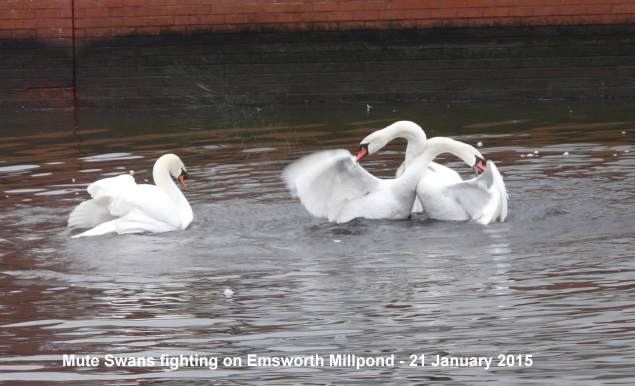
occasionally hurling
herself onto the two warring males

Eventually, one of the
males managed to get on top of the other male and
tried to push its head under the water, but did not
succeed. This went on for about 10 minutes during
which I took many photos and a video clip.
Link to YouTube video . . . https://www.youtube.com/watch?v=jKgN9pBilcs&feature=youtu.be
Questions
from Peter Milinets-Raby
Q1. What
happened to the female of the losing bird? I note that
the female of the winning bird hung around and
supported the male.
A: The female of the non-resident pair was a little
distance away and did not take part in the fighting.
Q2. Were the pair that
won the owner of the juv that was swimming around and
not being chased off?
A: Yes, the young bird lurking around in the
background was the sole survivor of last year's brood
of the resident pair. Unlike the Langstone Mill Pond
swans the juvenile has not yet been chased off by the
parents, though this is bound to happen soon.
Q3. So, does this mean
that the pair that nested last year have won the right
to nest again? Or is there still more fighting to be
done?
A: What I am calling the resident pair have nested on
the millpond for the last two years. They built the
famous 'litter nest' near the north bridge. They have
driven off all the other swans from the millpond and
the only swans brave enough to venture on the pond are
this visiting pair. I think it is the same pair that
tried to encroach last year also, but without success.
There used to be a flock of 50+ at this time of the
year. I am sure the fighting is not over. The visiting
pair did not give up easily last year.
Local residents are
organising a scheme to provide nesting material to the
swans this year so they don't have to rely on litter.
They hope to encourage the visiting pair to nest in
the southern section of the pond well away from the
resident pair, but personally I reckon that is too
much to hope for.
Garden
birds
I kept a close
eye on the birds visiting my garden today, just in
case anything unusual turned up, like a Brambling or a
Siskin. But no, there was nothing special. However,
the regulars were all pretty active including the male
Great Spotted Woodpecker which has discovered the
delights of sunflower hearts.
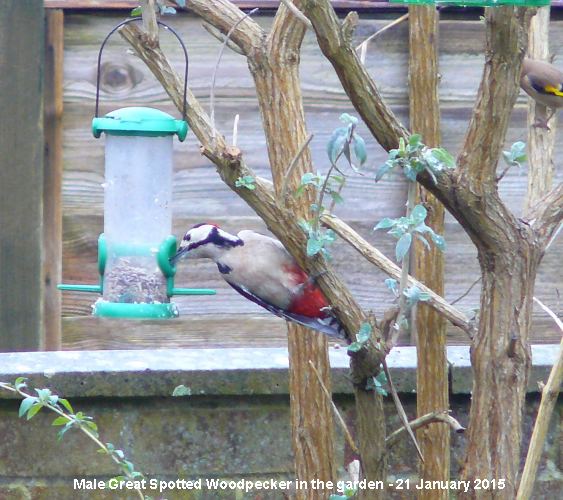
I also had the regular
female Blackcap pecking away at an old apple I had
stuck onto the Buddleja bush, but I have yet to see a
male. Patrick Murphy also reports a regular female
Blackcap in his garden, but no male. Tony Wootton has
also had a female in his garden and got this excellent
image of the bird. Males appear to be a bit scarce
this winter?

Yesterday Patrick
Murphy had a treat in the form of a male Bullfinch in
his garden. I haven't seen one of those for ages.
Langstone
Mill Pond
Peter
Milinets-Raby had another look at the Langstone Mill
Pond this morning (same time 10am to 11am - high tide
again - very grey day with light damp drizzle). Grim
grey weather!
The island in the middle of the channel was just
submerging as I arrived so I managed to see a few
waders leave and head towards Hayling Bridge. These
were: 55+ Lapwing, 30+ Grey Plover, 25+ Dunlin,
Otherwise very little around.
On the pond: Male and female Wigeon, Female Goosander
asleep on the tree at the furthest corner of the pond
(see poor record photo).
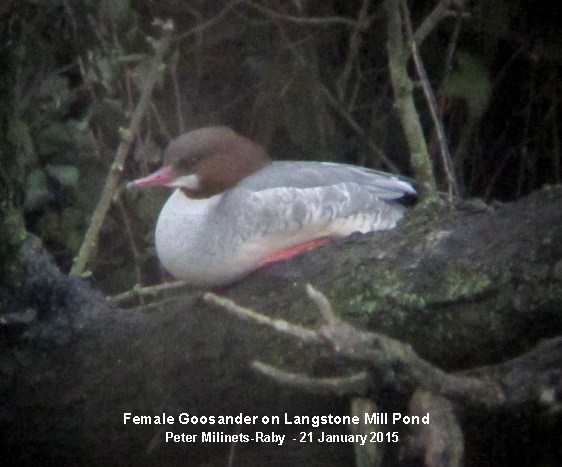
No sign of any Grey
Heron on the Holm Oak nests, but almost certainly
present, tucked down tight against the damp grey
weather. The south nest held two birds again, one
standing the other sitting very low, almost impossible
to see, so not surprised that the Holm Oak birds were
not visible. These birds are obviously on eggs. What
is the incubation time? Answer: 25-28 days.
Mute Swan pair on their own on the pond - kids kicked
out and no where to be seen. Very aggressive birds
attacking my shoes as I watched the Goosander.
Off shore on the high tide water: 87 Shelduck, 46
Wigeon, 250+ Brent Geese, 14 Red Breasted Merganser, 5
male and 4 female Pintail (see the poor record
photos), 3 female Goldeneye. Flooded horse paddock: 59
Teal, 21 Moorhen,

TUESDAY
JANUARY 20 - 2015
Brook
Meadow
Malcolm
Phillips went round the meadow early this afternoon.
He said there was not too much movement. However, he
did get a Long-Tailed Tit collecting nesting
material and Malcolm's photo is enough to gladden the
heart on this cold winter's day.

The Long-tailed Tit
nest is an elaborate domed structure densely packed
with feathers, bound with spider's webs and covered in
lichen. The nest may be low in dense cover (e.g.
brambles) or high in a tree against a trunk and may
take up to a month to build. Even so, this is quite an
early start to nest building. Here is a photo of one
on Brook Meadow taken by Maurice Lillie in March 2012
- showing well the lichen covering over the nest.
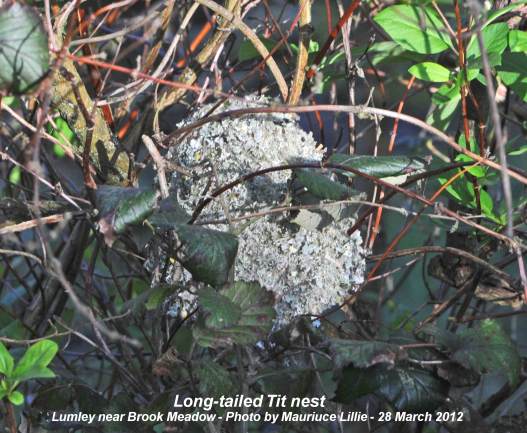
Malcolm also saw a
Song Thrush in Palmers Road Copse taking a
worm. Song Thrushes are usually associated with
snails, but they will also take worms as well as a
variety of insects. In addition, they eat fruit in
autumn and winter.

Langstone
Mill Pond
Peter
Milinets-Raby walked to the Langstone Mill Pond this
morning at 10am for an hour (high tide and an
overnight frost down to -3C). He entered along Wade
Lane - very icy with frozen ground everywhere. Three
plus Song Thrushes seen, along with a handsome male
Bullfinch. Little Egret feeding in one horse paddock.
The flooded horse paddock was frozen solid and only
occupied by 17 Moorhen. No Teal.
On the high tide channel were: 19 Teal, 57 Wigeon,
300+ Brent Geese, 73 Shelduck, 1 male and 2 female
Goldeneye. The resident pair of Mute Swans were
chasing away several times (with vigour and with lots
of flying and chasing) their 3 offspring - time to
move on kids!!
The pond was surprisingly not frozen! 7 Little Egrets
roosting on the trees at the back. Male & female
Wigeon, 2 Grey Heron roosting, 11 Teal. All three Grey
Heron nests occupied. A Grey Heron was watched flying
in with a stick onto the top nest in the Holm Oak,
where a sitting bird emerged from the vegetation to
arrange the stick into place before nestling down
again!
SUNDAY
JANUARY 18 - 2015
Swan
nesting news
You will
recall, that for the past two years, the resident Mute
Swan pair on the town millpond have constructed their
nest near to the road bridge from litter and other
miscellaneous debris found around the pond.

Clearly, that was not
very satisfactory, though the swan pair did manage to
rear one cygnet in each of the two years. This year
local resident, Jackie-Michelle Daines is determined
to improve their nesting facilities. Jackie's first
idea was to install a raft, but on the advice of the
Queen's Swan Master, whom she consulted, that was
ruled out as swans do not like to nest on anything
that moves. Interestingly, the swans on Slipper
Millpond have never taken any interest in nesting on
the rafts on that pond probably for that reason. The
Swan Master's advice was to provide them with good
nesting material (e.g. water reeds) and let the swans
do the rest.
Following this advice, Jackie contacted a local
thatcher who kindly offered to donate as much reed as
was needed to enable the swans to build the nest
properly. He will deliver the reed to Jackie's house
in Havant in February and she will then slowly feed
the reed to the swans so they can build their nest.
Jackie says it is no use just dumping the reed on to
the nest site, it needs to be fed to the swans in
short bits so they can build the nest. She thinks they
are likely to build the nest in the same place as
before near the bridge.
As for the other pair of swans that are currently
vying with the residents for territory on the
millpond, Jackie thinks they could nest by the new
wall around Swan House (used to be Tenerife Cottage)
in Bath Road. There is a section of exposed gravel
there that the swans could use.
HBC have already been approached and are quite happy
so long as the nest material does not block any pipes,
etc. Jackie added that HBC no longer control the town
pond they just maintain the vegetation around the
edges and clear the rubbish when requested by the
Environment Agency. The EA now have responsibility for
the pond on a day to day basis, eg maintaining the
water levels.
Well, all seems to be in place, so, let the show
commence!
SATURDAY
JANUARY 17 - 2015
Jay
in Nore Barn Woods
I met Chris
Berners-Price in Emsworth this morning. He had been
for a walk around Nore Barn Woods where he heard a Jay
calling. This was the first one he had ever heard in
the woods and hoped it indicated a pair taking up
residence.
Baffins
Pond
Master Thomas
Irons and his parents had a wonderful afternoon at
Baffins Pond. Thomas really enjoyed spotting all the
different species of birds. Yes, Baffins Pond is such
a good place to get really good views of birds. Here
are a few of Thomas's sightings that his mother,
Glynis, sent to me. The left side photo is a male
Tufted Duck. But the duck on the right defies
identification. Thomas named it "the duck amongst the
pigeons" which is as good as any, I suppose!
The Irons family also
witnessed a kind man removing a fishing line which had
got tangled around the leg of this Feral Pigeon.

For more details on
Baffins Pond go to . . . Baffins
Pond
Mystery
caterpillar
Ralph Hollins
thinks the caterpillar that Chris Oakley had on the
Hampshire Farm site is most likely to be Ruby Tiger.

This is one of the
many moth caterpillars that hibernate over winter.
Ralph gives the following link to a photo which is the
cosest match to the hairiness, hair colour and the
underlying black body colour of Chris's photo.
http://www.wildlifeinsight.com/Insight/wp-content/gallery/gb_caterpillars/ruby-tiger_3514.jpg
Farlington
Marshes
Ros Norton
reported on this morning's walk by the Havant Wildlife
Group. Highlights included a juvenile Spoonbill and a
partially albino (leucistic) Canada Goose. For the
full report see . . . Havant
Wildlife Group
(2015 reports)
FRIDAY
JANUARY 16 - 2015
Emsworth
Harbour
I had a quick
look at the harbour from the marina seawall at about
12 noon. There were plenty of Brent Geese in the
harbour and hundreds of Dunlin mainly feeding along
the edges of the channels.
The most interesting birds in the harbour were 24
Gadwall in the low water channel near the town,
mostly in male-female pairs. Gadwall are regular
visitors to the harbour at this time of the year; they
seem to arrive with the wintering Coot, of which there
were around 100 in the channel.

I also noted 14
Lapwing on the seaweed covered rocks, plus a few
Black-tailed Godwits and a couple of Greenshank; none
were colour-ringed.
Brook
Meadow
Malcolm
Phillips got a couple of nice photos on Brook Meadow
today. A Song Thrush - what a cracking bird
that is. That is probably the one you can hear singing
from the east side of the meadow.
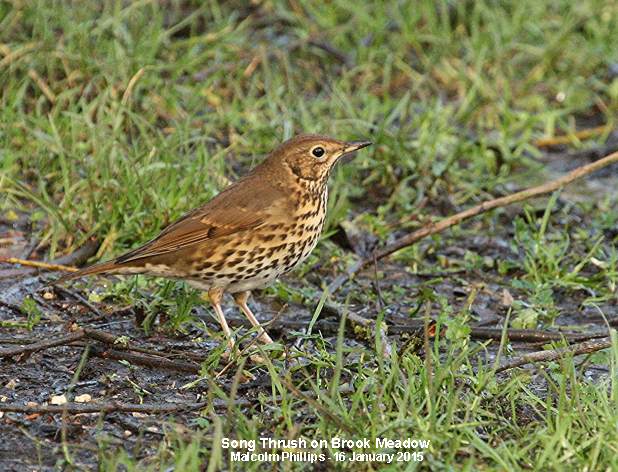
And this House
Sparrow which looks very sorry for itself, having
been caught in a shower of rain.

Hampshire
Farm
Chris Oakley
walked round the Hampshire Farm open space area this
afternoon. Here is his report: "It was a beautiful
winter's day with a light west wind and extremely
mild. The pond is at its expected level for this time
of the year despite the recent rain, and the outfall
into the river at Bourne bridge is quite low. There is
a small amount of standing water especially along the
eastern hedge line and the stream, although flowing
quite fast, is far from bank-full. Where the water
outlets into the pond the grass is noticeably green
and lush unlike the rest which has taken a pounding
over the last few weeks.
The horses in the top east meadow have new neighbours;
four big white pigs. The log piles still have a few
Bonnet fungi but the yellow Stag's horn has gone at
last. I was surprised to find a small furry
Caterpillar under a piece of bark, it was about 30mm
long. I would hazard a guess that it's one of the
Tiger Moths. I know they were around there in the
summer.

The open grass area is
covered in millions of thread cob-webs. There are so
many that they make the field look quite silver
against the sun. I saw only one spider, a small shiny
brown one of about 3mm long.
Sparrowhawk
encounter
Yesterday,
Charlie Annalls had the pleasure of a visit from this
magnificent male Sparrowhawk in her neighbour's garden
for about 20 minutes. Charlie lives near Hilsea in
Portsmouth. This male has the brightest brown
underparts that I have ever seen. Quite magnificent.
Actually, Charlie was about to leave for a quick trip
to Brook Meadow, but on seeing the hawk she couldn't
pass up such an opportunity! He was first seen on the
gate.

He then swooped down
to where the mice play but didn't get anything. He
then sat amongst the birdfeeders and looked
contemptuously at the fat slab, looking up and around
for any potential prey.
Later Charlie heard
the thwack of bird meeting bird and found a pile of
pale feathers belonging to a Collared Dove, which
survived the attack and flew off. I doubt if the dove
would have survived an attack from the much larger and
more powerful female Sparrowhawk. This was Charlie's
first Sparrowhawk and was thrilled to see him.
Charlie did eventually get to Brook Meadow but it was
pouring and nothing of much interest to see today
except a very tame and tuneful Robin.
For
earlier observations go to . . January
1-15